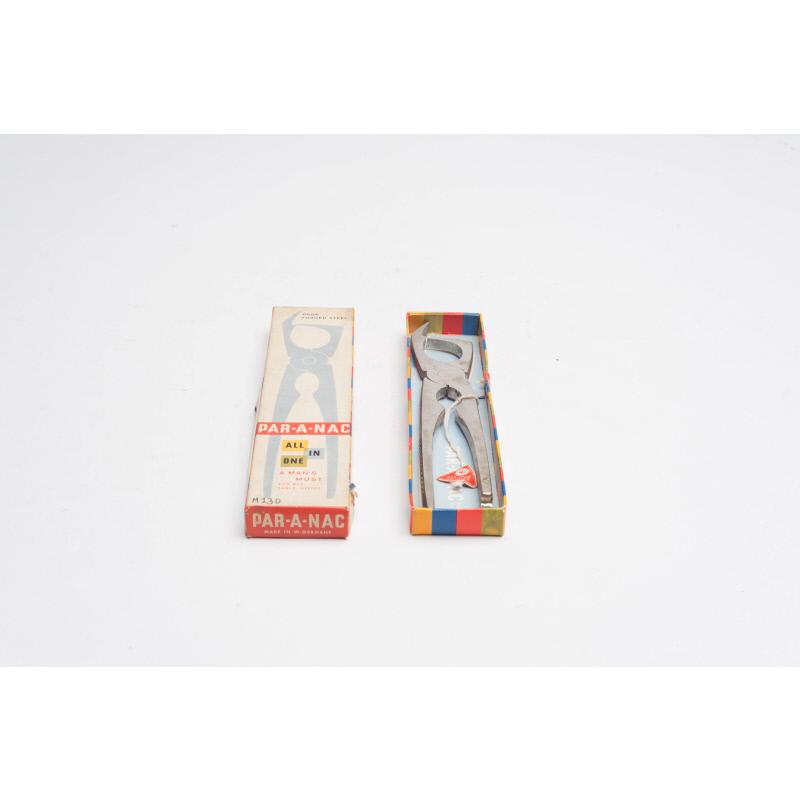Multi tool
Classification(s):
Metal
Date: c.1951 - 1976
Organisation: Wüsthof
Dimensions:
16 × 203 mm (1.6 × 20.3 cm)
Medium: Drop forged steel
Object number: M130
Place of Production:West Germany
Title:Par-a-nac
Description'Par-a-nac' all in one multi tool. Described on the box as “A man’s must for bar, table, office”. Manufactured by Wüsthof in Solingen, West Germany. The multi tool is complete with its original box and is made from drop forged steel. The multi tool allows the user to screw nails, break ice cubes or lobster claws, open champagne corks and punch tin cans. Printed on the interior of the box lid “Can you shell a brazil nut? You can do it with the PAR-A-NAC! At first take the backside with the cutter. Try it and you will do it better next time!”
The product label is attached ‘Dreizack Solingen’, it bears the trident logo from the company’s crest. Engraved on the tool “Paranac Germany”.
The product label is attached ‘Dreizack Solingen’, it bears the trident logo from the company’s crest. Engraved on the tool “Paranac Germany”.
ProvenanceThis object was originally acquired for the Inner London Education Authority’s (ILEA) ‘Circulating Design Scheme’ collection.
The collection was instigated by the London Country Council (later the Greater London Council) and the Council of Industrial Design (COID). The collection’s original purpose was concerned with the teaching and dissemination of modern, ‘good design’.
The collection was established in 1951/52 as the ‘Experiment in Design Appreciation’, later renamed the ‘Circulating Design Scheme’.
The Circulating Design Scheme lent boxed showcases to London schools. The showcases contained handling objects, material samples and interpretation on a specific subject.
COID withdrew its involvement in the Scheme in 1957. After which time, it was managed exclusively by the London County Council from 1957-1963.
After the administrative restructuring of London authorities, the Scheme was jointly managed by the Greater London Council and the Inner London Education Authority (ILEA) from 1963 – 1976.
The Scheme was operational until 1976 when the collections were withdrawn from circulation. ILEA was abolished in the late 1980s and the collection was donated to Camberwell College of Arts in 1989/90.
ILEA was responsible for secondary and tertiary education in the inner London boroughs, this included Camberwell.
The collection was instigated by the London Country Council (later the Greater London Council) and the Council of Industrial Design (COID). The collection’s original purpose was concerned with the teaching and dissemination of modern, ‘good design’.
The collection was established in 1951/52 as the ‘Experiment in Design Appreciation’, later renamed the ‘Circulating Design Scheme’.
The Circulating Design Scheme lent boxed showcases to London schools. The showcases contained handling objects, material samples and interpretation on a specific subject.
COID withdrew its involvement in the Scheme in 1957. After which time, it was managed exclusively by the London County Council from 1957-1963.
After the administrative restructuring of London authorities, the Scheme was jointly managed by the Greater London Council and the Inner London Education Authority (ILEA) from 1963 – 1976.
The Scheme was operational until 1976 when the collections were withdrawn from circulation. ILEA was abolished in the late 1980s and the collection was donated to Camberwell College of Arts in 1989/90.
ILEA was responsible for secondary and tertiary education in the inner London boroughs, this included Camberwell.




